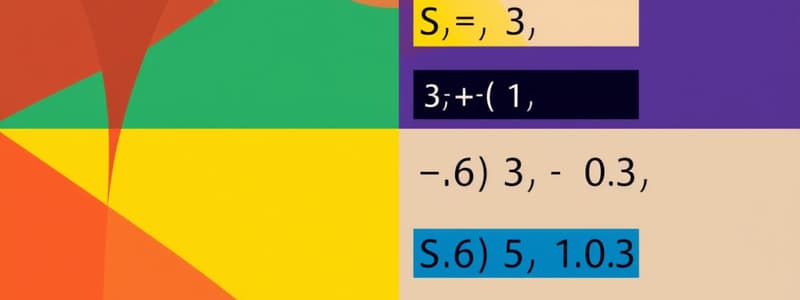Podcast
Questions and Answers
What is the primary mechanism used in selection sort to reorder elements?
What is the primary mechanism used in selection sort to reorder elements?
- Finding and swapping the minimum value with the first position (correct)
- Interchanging adjacent elements systematically
- Dividing the list into sublists and sorting each
- Comparing and swapping elements in pairs until ordered
What is the time complexity of simple selection, bubble, and insertion sorts?
What is the time complexity of simple selection, bubble, and insertion sorts?
- O(log n)
- O(n log n)
- O(n^2) (correct)
- O(n)
Which sorting algorithm repeatedly swaps adjacent elements to sort a list?
Which sorting algorithm repeatedly swaps adjacent elements to sort a list?
- Insertion sort
- Selection sort
- Bubble sort (correct)
- Mergesort
In which sorting method is a heap utilized to enhance selection sort?
In which sorting method is a heap utilized to enhance selection sort?
Which sorting algorithm exemplifies the divide-and-conquer strategy?
Which sorting algorithm exemplifies the divide-and-conquer strategy?
What is a characteristic feature of radix sort compared to other sorting methods?
What is a characteristic feature of radix sort compared to other sorting methods?
What is the main drawback of O(n^2) sorting algorithms?
What is the main drawback of O(n^2) sorting algorithms?
In selection sort, which statement accurately describes the process?
In selection sort, which statement accurately describes the process?
What is the worst-case time complexity of Quicksort when the list is already ordered in reverse?
What is the worst-case time complexity of Quicksort when the list is already ordered in reverse?
How can the depth of recursion in Quicksort be minimized?
How can the depth of recursion in Quicksort be minimized?
What is the median-of-three rule used for in Quicksort?
What is the median-of-three rule used for in Quicksort?
What strategy might lead to poor partitioning during the Quicksort process?
What strategy might lead to poor partitioning during the Quicksort process?
What is an alternative method to manage recursion depth in Quicksort?
What is an alternative method to manage recursion depth in Quicksort?
What happens when Quicksort is applied to a nearly sorted list using a poor pivot selection?
What happens when Quicksort is applied to a nearly sorted list using a poor pivot selection?
What is the role of the variable 'last' in the bubble sort algorithm?
What is the role of the variable 'last' in the bubble sort algorithm?
How are the children of a node at index 'i' found in a heap data structure?
How are the children of a node at index 'i' found in a heap data structure?
What describes the purpose of the reheapDown operation in a heap?
What describes the purpose of the reheapDown operation in a heap?
What is the average case time complexity of the quicksort algorithm?
What is the average case time complexity of the quicksort algorithm?
When building a heap, what is the index of the first leaf node in a complete heap of size 'n'?
When building a heap, what is the index of the first leaf node in a complete heap of size 'n'?
In the bubble sort algorithm, what happens to the variable 'numCompares' in each iteration?
In the bubble sort algorithm, what happens to the variable 'numCompares' in each iteration?
What is the correct way to denote the parent of a node located at index 'i' in a heap?
What is the correct way to denote the parent of a node located at index 'i' in a heap?
In a complete heap, what is the index of the last nonleaf element determined by?
In a complete heap, what is the index of the last nonleaf element determined by?
Flashcards are hidden until you start studying
Study Notes
Sorting Methods
- Sorting methods can be categorized into three types: selection, exchange, and insertion.
- Simple sorts such as selection sort, bubble sort, and insertion sort operate with a time complexity of O(n²), making them less efficient for large datasets.
Selection Sort
- Selection sort involves making multiple passes through a list to reposition elements correctly.
- The algorithm identifies the minimum value, swaps it with the first element, and continues this process for the rest of the list.
- Basic implementation includes nested loops where the outer loop tracks the current position and the inner loop scans for the minimum value to swap.
Bubble Sort
- Bubble sort works by repeatedly swapping adjacent elements if they are out of order.
- The process continues until no swaps occur in a complete pass through the list, denoted by the numCompares variable.
- It is intuitive but also inefficient for larger datasets.
Heaps and Heap Sort
- A heap is a specialized tree-based data structure that supports priority queues.
- Key operations include reheapUp (to fix a broken heap by floating an element up) and reheapDown (to fix it by pushing an element down).
- The structure defines relationships:
- For a node at index i, the left child is at 2i + 1 and the right child at 2i + 2.
- The parent node for index i is found at (i - 1)/2.
Quicksort
- Quicksort is a divide-and-conquer sorting algorithm, significantly more efficient than O(n²) sorts, with an average case of O(n log n).
- It partitions the list around a pivot, recursively sorting the smaller and larger sublists.
- The performance can degrade to O(n²) if the pivot choice consistently leads to unbalanced partitions (e.g., a sorted list).
Improvements to Quicksort
- To enhance quicksort efficiency, sorting the smaller sublist first can reduce recursion depth and overhead.
- An iterative version can eliminate excessive recursion stack usage by maintaining start and end indices of sublists in a separate stack.
- The median-of-three pivoting technique improves performance on nearly sorted lists by selecting the median of the first, middle, and last elements as the pivot, leading to better balance.
Non-comparison-based Sorts
- Radix sort exemplifies a non-comparison sort, efficient for specific dataset types by processing elements based on individual digits instead of comparing their values.
Studying That Suits You
Use AI to generate personalized quizzes and flashcards to suit your learning preferences.




